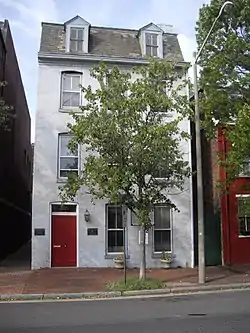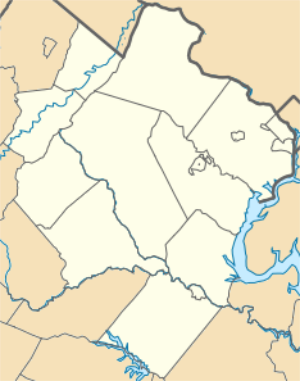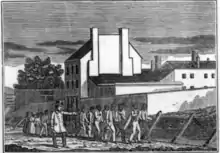Franklin and Armfield Office
The Franklin and Armfield Office, which houses the Freedom House Museum, is a historic commercial building in Alexandria, Virginia (until 1846, the District of Columbia). Built c. 1810-20, it was first used as a private residence before being converted to the offices of the largest slave trading firm in the United States, started in 1828 by Isaac Franklin and John Armfield. "As many as [a] million people are thought to have passed through between 1828 and 1861, on their way to bondage in Mississippi and Louisiana".[4] Another source, using ship manifests (lists of slaves) in the National Archives, gives the number as "at least 5,000".[5]
Franklin and Armfield Office | |
 Freedom House | |
    | |
| Location | 1315 Duke Street, Alexandria, Virginia |
|---|---|
| Coordinates | 38°48′14″N 77°3′17″W |
| Area | 27 acres (11 ha) |
| Built | 1810 |
| Architect | Robert Young |
| Architectural style | Federal |
| NRHP reference No. | 78003146 |
| VLR No. | 100-0105 |
| Significant dates | |
| Added to NRHP | June 2, 1978[1] |
| Designated NHL | June 2, 1978[2] |
| Designated VLR | October 16, 1979[3] |
The former Franklin & Armfield Office building is located just west of Alexandria's Old Town, on the north side of Duke Street between South West and South Payne streets. It is a three-story brick building, topped by a mansard roof and resting on a brick foundation. Its front facade is laid in Flemish bond, while the sides and rear are laid in common bond. It has Federal-period styling, with windows and the entrance door set in segmented, arch openings, with gabled dormers at the roof level.[6]
The building was designated a National Historic Landmark in 1978, and has also been designated a Virginia Historic Landmark. The building is owned by the Northern Virginia Urban League; it is operated as a museum, with exhibits about the slave trading firm and the life of a slave.[7][8]
History
The building was constructed as a residence in the 1810s by Robert Young, a brigadier general in the District of Columbia National Guard. Due to financial reverses, Young was soon afterward forced to sell the house.
Franklin & Armfield
The building was purchased in 1828 by Isaac Franklin and his nephew John Armfield, who established it as their Washington-area office, and the residence of Armfield.[9]

The property then extended further east, and they added structures for holding and trading in slaves. They also provided, for 25¢ a day, housing in their jail for slaveowners visiting Washington.[10]:292 The two-story extension to the rear of this house was part of the slave-holding facilities, which included high walls, and interior chambers that featured prison-like grated doors and windows. Franklin left the business, starting in 1835, and Armfield sold the property to another slave trader in 1836.
Price, Birch and Co.

From 1858, the building was occupied by Price, Birch & Co. an American slave trading company founded in 1858 by George Kephart, William Birch, J. C. Cook, and C. M. Price.[10]:29[11][12]
Price, Birch & Co. ceased business in 1861.[13][14] Arriving at the Duke street office of the company on May 14, 1861, the Union Army discovered that "The firm had fled, and taken with them all but one of the humans that they sold as slaves — an old man, chained to the middle of the floor by the leg."[15][16] Union forces then took possession of the building until February 2, 1866, using it as a military prison.[6][17][18] Late in the war, it was used as L'Ouverture Hospital for black soldiers, and as housing for contrabands.[10]:293
Use after the Civil War
After the war, the building's outlying slave pens, of which there are photographs,[12] were torn down. The bricks may have been reused in the construction of the adjacent townhouses.[6] After serving a variety of other uses, the main building is now used for Freedom House Museum, with exhibits devoted to the slave trade. The second floor houses the offices of the Northern Virginia Urban League.
In 2005, the Virginia Department of Historic Resources erected the following marker in front of the building:
Franklin and Armfield
Slave Office (1315 Duke Street)Isaac Franklin and John Armfield leased this brick building with access to the wharves and docks in 1828 as a holding pen for enslaved people being shipped from northern Virginia to Louisiana. They purchased the building and three lots in 1832. From this location Armfield bought bondspeople at low prices and shipped them south to his partner Franklin, in Natchez, Mississippi, and New Orleans, Louisiana, to be sold at higher prices. By the 1830s they often sold 1,000 people annually, operating as one of the largest slave-trading companies in the United States until 1836. Slave traders continually owned the property until 1861.[19]
See also
References
- "National Register Information System". National Register of Historic Places. National Park Service. April 15, 2008.
- "Franklin & Armfield Office". National Historic Landmark summary listing. National Park Service. Archived from the original on 2007-12-31. Retrieved 2008-06-26.
- "Virginia Landmarks Register". Virginia Department of Historic Resources. Retrieved 2013-05-12.
- Sullivan, Patricia (February 14, 2018). "Alexandria council loans $63,000 to stabilize slave-trading museum". The Washington Post. Retrieved February 14, 2018.
- Sweig, Donald (October 2014). "Alexandria to New Orleans: The Human Tragedy of the Interstate Slave Trade" (PDF). Alexandria Gazette-Packet. Retrieved February 13, 2018.
- "NHL nomination for Franklin and Armfield Office". National Park Service. Retrieved 2016-01-26.
- "Freedom House Museum". The Smithsonian Associates. Retrieved 5 October 2015.
- "Alexandria museum of slave trade damaged by winter storms". The Washington Post. March 4, 2015. Retrieved 5 October 2015.
- Gudmestad, Robert H. (Fall 2003). "The Troubled Legacy of Isaac Franklin: The Enterprise of Slave Trading". Tennessee Historical Quarterly. 62 (3): 193–217. JSTOR 42627764.
- Loewen, James W. (1999). Lies Across America. What Our Historic Sites Get Wrong. The New Press. ISBN 1565843444.
- https://www.metmuseum.org/art/collection/search/283193
- My Genealogy Hound. "Alexandria, Virginia, Price and Birch, Armsfield and Franklin, Slave Pen, Historic Photos". Retrieved February 12, 2018.
- "Out of the Attic: Notorious local slave dealer had hand in Solomon Northup's kidnapping | Alexandria Times | Alexandria, VA".
- "Franklin and Armfield Office (U.S. National Park Service)".
- Conway, Moncure Daniel (1865). Testimonies Concerning Slavery. London: Chapman and Hill. p. 22.
- https://www.alexandriava.gov/uploadedFiles/historic/info/archaeology/SiteReportArtemel1987SlavePenAX75.pdf
- Friedman, Saul S. (2000). Jews and the American Slave Trade. ISBN 9781412826938.
- "Congressional series of United States public documents". 1870.
- http://www.markerhistory.com/Images/Low%20Res%20A%20Shots/e-131%20franklin%20and%20armfield%20slave%20office%20(1315%20duke%20street).jpg
Further reading
External links
| Wikimedia Commons has media related to Franklin and Armfield Office. |

